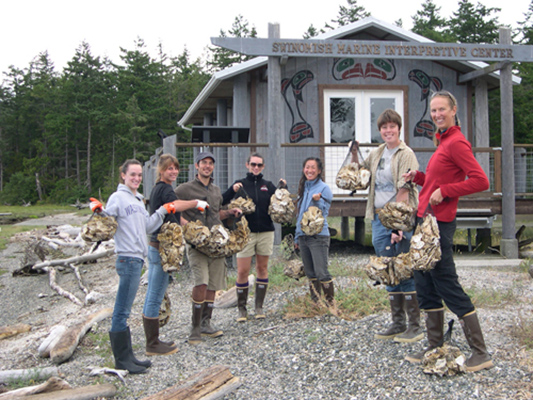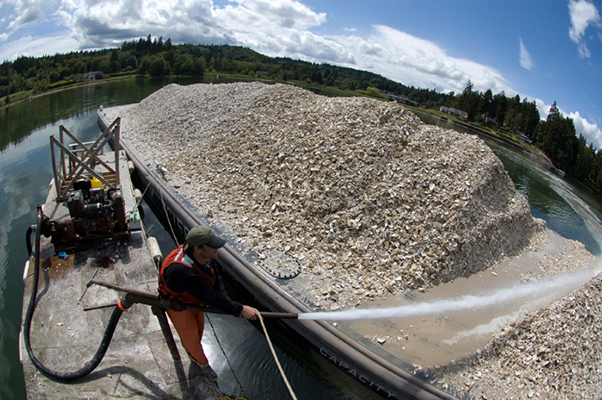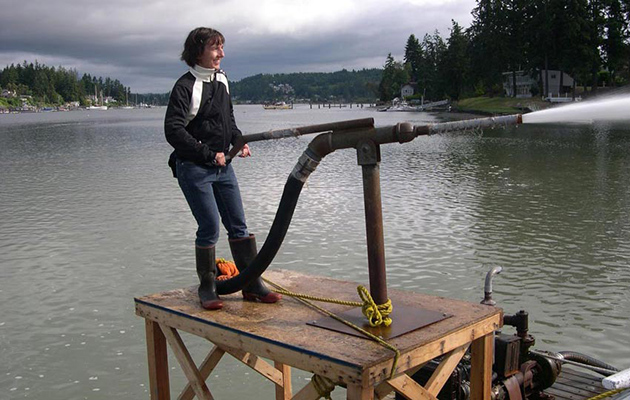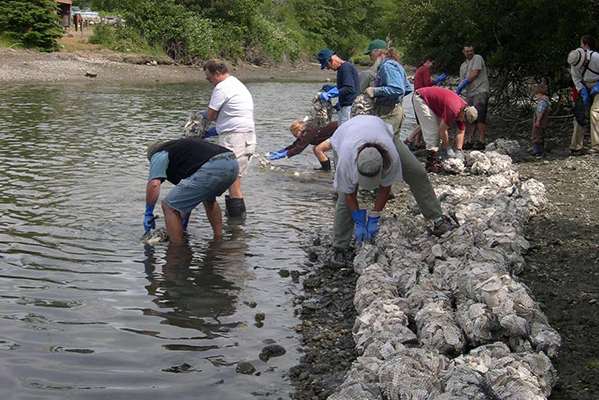Overview
The Olympia oyster, the Pacific Northwest coast’s only native oyster, ranges from southeastern Alaska to Baja, California. For thousands of years, Olympia oysters provided sustenance for tribes and habitat for a host of marine organisms. Until the late 1800s, Olympia oysters were the most abundant bivalves in Puget Sound, where they occupied thousands of acres of productive, diverse habitat. Over-harvesting, sediment loads, and pollution drove the oyster to near extinction. Today, it occupies a fraction of its former range and is a Candidate Threatened Species in Washington State and a priority species for restoration.
Since 1999, the Olympia Oyster Restoration Project has brought together more than 100 partners from the seafood industry, Indian tribes, state agencies, the U.S. Navy, local environmental organizations, schools, and property owners to: 1) identify appropriate habitats for oyster restoration, 2) modify substrate for growing oysters by adding old oyster shells, 3) propagate and seed oyster spat, and 4) monitor results.
Quick Facts
Project Location:
Olympia, WA, USA, 47.7236535, -122.4713352
Geographic Region:
North America
Country or Territory:
United States of America
Biome:
Coastal/Marine
Ecosystem:
Coral Reef, Seagrass & Shellfish Beds
Organization Type:
Other
Location
Project Stage:
Implementation
Start Date:
1999-01-01
End Date:
2008-07-15
Primary Causes of Degradation
Fisheries & Aquaculture, Urbanization, Transportation & Industry, OtherDegradation Description
For thousands of years, human communities capitalized on Puget Sound’s native oysters. Particularly in the south Sound, native tribes often sited their villages near large beds of Olympia oysters. Members of what is now known as the Squaxin Island Tribe recall the often densely concentrated shellfish as something akin to their “daily bread” “” there for the taking any time the tide was out. The first European settlers to the area gathered Olympia oysters from wild populations, primarily for sustenance and perhaps for local sale. In the 1850s, northern California’s gold prospectors brought their appetites for oysters with them from the East Coast and often celebrated large strikes with enormous quantities of oysters and champagne. A plate of native oysters sold for as much as $20 “” the equivalent of about $400 today. Overharvesting, pollution and sedimentation took their tolls on San Francisco Bay’s oyster stocks, forcing seafood sellers to turn to Willapa Bay in the Washington Territory for relief. Merchants shipped Willapa Bay native oysters to San Francisco as fast as they could be harvested. As the oysters were shipped in their shells, however, the hard substrate necessary for larval settlement gradually disappeared. Overharvesting and the steady reduction of settling habitat spelled disaster. By the 1870s, Willapa’s oyster stocks had been exhausted. Olympia oysters in Puget Sound were initially spared the burden of overharvest, largely because oysters shipped by sea to San Francisco would spoil before they reached the city. Harvest was thus highly localized, and few instances of overharvest occurred before Washington’s statehood in 1889. At that point, titles to all tidelands passed to the State of Washington. Six years later, state legislators passed laws allowing the sale of oyster beds to individuals already occupying adjacent land or cultivating natural oyster beds. Washington’s oyster farmers would soon discover diking, a method that eventually encompassed more than a thousand acres of tidelands. Oyster dikes “” first made of logs and later built from concrete “” took advantage of the native oyster’s tendency to settle and thrive in areas consistently under water. At a time when natural beds of native oysters were beginning to be depleted, dikes offered a means by which growers could greatly expand available acreage for shellfish farming. Yields in the first years of Olympia oyster harvest in Puget Sound may have been as high as 100,000 bushels annually, but had dropped by 1910 to a mere 29,000 bushels. Over the next 15 years “” a period of extensive diking “” production once again increased to as many as 40,000 bushels per year. A low point in Olympia oyster production occurred soon after 1927, the year that a sulfite pulp mill began operating in Shelton and discharging untreated sulphite waste liquor (SWL) into Oakland Bay. SWL is highly toxic and affected private and commercial oyster beds almost immediately, preventing oyster larvae from setting and killing most adult oysters. A series of experiments in the 1930s, 40s and 50s demonstrated that polluted wastewater from the mill circulated throughout southern Puget Sound. Other experiments established that SWL concentrations as low as eight parts per million were deleterious to oysters. By 1957, the year the pulp mill permanently closed, most Olympia oyster growers in southern Puget Sound had already switched over to cultivating the non-native Pacific oyster. Despite subsequent water quality improvements, the damage to native oyster stocks had been done. By 1960, overharvesting had nearly exterminated native oyster beds in Willapa and Samish bays, and pollution had wiped out most of south Puget Sound’s once-thriving Olympia oyster populations. Olympia oysters have survived in north and central Puget Sound, and populations in the south Sound and Hood Canal are, by some accounts, gradually recovering. Water quality has generally improved over the past 40 years, and strict regulations have alleviated harvest pressure on remaining wild oyster populations. Nonetheless, more than 150 years of habitat modification have taken their toll. Continued development around shorelines introduces silt to the ecosystem and the construction of bulkheads and dikes can scour beaches, damaging Olympia oyster beds that have only recently begun to recover.
Reference Ecosystem Description
Characteristics of suitable intertidal habitat for Olympia oysters include: Firm substrate “” composite areas of sand, mud, shell material and rock. Olympia oysters are prone to sinking when placed on soft substrate. Few predators “” For peak productivity, sites must be fairly free of oyster drills, sea stars, moon snails and other natural enemies of oysters. It should be noted that dense Olympia oyster populations are occasionally found co-occurring with dense populations of drills and other predators, suggesting the oysters may withstand intense predation pressure under some conditions. High degree of protection “” Estuaries, coves and bays may shelter Olympia oysters from movement and potential damage by currents and wave action. Consistent sources of water “” Unlike Pacific oysters, which can withstand periodic exposure at low tides, Olympia oysters are vulnerable to high and low temperatures if not covered by water. Freshwater influences “” Olympia oysters thrive in the brackish waters found near estuaries, stream outlets and the heads of bays. Olympia oysters have remarkable capacities to persist in suitable habitats throughout Puget Sound and Hood Canal. During spring and summer months, shellfish biologists from WDFW and partners in oyster reestablishment annually survey beaches thought to have extant populations of Olympia oysters. They often find evidence that Olympia oyster populations are maintaining themselves “” and, in some instances, thriving “” at locales from Budd Inlet to the northern San Juan Islands.
Project Goals
The decline of Olympia Oysters throughout the Puget Sound region was of concern to policymakers when the 1998 Stock Rebuilding Plan was initiated under the authority of the Washington State Department of Fish and Wildlife (WDFW). The concern from the outset was that the oyster population was threatened to the point of requiring listing as a threatened species. The Puget Sound Restoration Fund became involved in the project in 1999.
Monitoring
The project does not have a monitoring plan.
Stakeholders
By 1998 the Olympia oyster was a candidate for review as a possible state threatened, endangered or sensitive species, due to concern over low population levels. In that year, the Washington Department of Fish and Wildlife (WDFW) developed the Olympia Oyster Stock Rebuilding Plan. Since that time, on-the-ground reestablishment efforts spearheaded by the Puget Sound Restoration Fund (PSRF) have greatly assisted the Olympia oyster’s return. PSRF has assisted in spreading over five million oysters at more than 80 experimental sites, with assistance from over 100 project partners.
Description of Project Activities:
The first step in the process was to find intertidal areas with extant native oyster populations or those containing evidence of existing populations in the past, such as historic mounds of oyster shells that indicate prior shellfish abundance. Once these sites were located, a supply of juvenile Olympia oysters with which to seed the site was necessary. Seed oysters were acquired from a hatchery or by capitalizing on natural spawning and settling by wild stock. In order to preserve the genetic integrity of Olympia oyster populations, WDFW encouraged restorationists to draw from those populations that originated in the same management area in which the offspring would be spread. Uncertainty over whether the remaining oyster populations are form one population, or from a number of sub-populations necessitated the guidelines. Once a source for broodstock, or mature Olympia oysters is decided upon, a WDFW permit for collection was obatained. Next, the populations must be tested for shellfish-borne diseases because of concern over the spread of shellfish diseases through conservation efforts. Once certified that the broodstock are clear of infection the oysters were delivered to shellfish hatcheries in order to be conditioned for spawning readiness, which requires approximately one week in 55-to 61- degree F water. Once the oysters are spawned, the cultured larvae (or spat) are concentrated in small tanks where they settle on suitable substrate, often bits of Pacific oyster shell. This clutched larvae is bagged for shipping with as many as 6,000 Olympia oysters per bag, or they are kept at the hatchery and fed phytoplankton-rich water fro several months. Once the oysters reach the size of a pencil eraser, usually within three months of settling, the seed oysters are again tested by a pathologist before begin planted on the beach. Strict standards and permits are required by the WDFW to transfer, transport, and transplant oysters from one population to another. These clutched oysters are highly susceptible to exposure to air and require delicate care and careful planning for transport and seeding. This often is accomplished by layering damp blankets and tarps over bags of clutch in the back of an open-air pickup.
Once at the site, several seeding methods are used. Which method depends on a range of factors, including potential predation, size of seed, degree of exposure and substrate conditions. Traditional bottom culture involves scattering clutch across areas of suitable habitat without much concern for crowding, these bottom culture sites are best when there are few known predators and sufficiently firm substrate. In marginal habitat, or when seed is especially vulnerable to predation, seed can be left in mesh bags from the hatchery or transferred to rectangular, 1/8" to ¼" mesh grow out bags. This method requires that the shells be removed from the bags and spread by bottom culture after three or four months in the water. If this method is used, some care is necessary to give the oysters better odds to reach spawning age. Heavy currents, wave action, or other effects of beach exposure requires that tideland owners stake the grow-out bags to the beach with rebar or other material. Additionally, the bags must be periodically flipped to minimize siltation and potentially smothering the oysters on the bottom of the bags.
Another element of the effort is to locate specific habitat that conforms to specific criteria for native oysters and provide habitat enhancement. A variety of assessments are made to determine whether a particular location is a good candidate for consideration. The habitat enhancement treatment then is ideally employed as a stock-rebuilding technique in areas where structure is limited, but where recruitment potential, community structure and habitat requirements for native oysters exist. Without some form of complex structure on a tideland that lies exposed above beach sediments, native oyster larvae in the water column choose to move on. A habitat enhancement treatment provides the area with an emergent oyster setting structure to catalyze natural recruitment. Over time, these enhancements have proven effective by significantly increasing local native oyster stocks and are restoring viable populations at several locations in Puget Sound.
Ecological Outcomes Achieved
Eliminate existing threats to the ecosystem:
Approximately 5 million oysters have been planted at 80 experimental sites throughout Puget Sound. In 2007 alone, this work involved nearly 4 acres of tidelands directly seeded to Olympia oyster, workshops to promote continued restoration up and down the West coast, and habitat enhancement efforts throughout Puget Sound.
Factors limiting recovery of the ecosystem:
The location of suitable habitat is critical. Although numerous techniques can be employed to grow the oysters to maturing, from suspending them in bags form docks or other floating structures, to the use of longline cultural techniques (where lengths of rope is attached to small posts, with clutched shell or spat on the longline itself), all of these techniques require periodic maintenance. This effort also relies on many private landholders, as many tidal lands are privately held.
Socio-Economic & Community Outcomes Achieved
Economic vitality and local livelihoods:
The Olympia oyster was a significant element of the Puget Sound foodshed for thousands of years. The restoration of the Olympia oyster also serves as a lightning rod for other projects, from clean water work to watershed improvement to the elimination of pollutants from the waterways that feed into Puget Sound.
Sources and Amounts of Funding
Much of the resources that have been invested in Olympia Oyster restoration efforts have come via the Puget Sound Restoration Fund. This organization acts as the umbrella organization that acquires funding from individual and corporate contributions, foundation grants, government grants, and through tribal partnerships. These specific projects have gained funding from NOAA community-based restoration program, the Washington State Department of Fish and Wildlife, from various municipalities and tribal councils, private tideland owners, and even nonprofit entities such as the Nature Conservancy. Overall, the project draws from over 100 partners, with varying levels of financial commitment. The Puget Sound Restoration Fund in 2007 received a $1,000,000 bequest to support all of its various restoration efforts.
Other Resources
Peter-Contesse, Tristan. 2005. Reestablishing Olympia Oyster Populations in Puget Sound, Washington. Sea Grant Washington, University of Washington.





